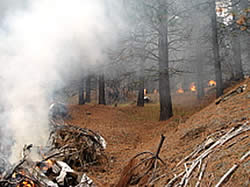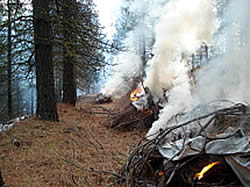
National Fire Plan Success Story
Colestine Thin / Hazardous Fuels Reduction Project
Oak Knoll / Happy Camp District, Klamath National Forest
National Fire Plan - Fuels Reduction
2008


Hand-pile unit burning within the Colestine project area.
Near the community of Colestine, Oregon the project area consists of approximately 450 acres of dense mixed conifer stands. Ponderosa and Jeffrey pine are the dominant species along with naturally recruited hardwoods. The area is one of the oldest plantations on the forest and was originally planted in 1937 following a stand replacing wildfire.
Project activities include thinning dense stands followed by treating fuels using a variety of techniques including hand-piling, chipping, whole tree removal and mastication. On the steeper slopes the treatment involved cutting the trees and hand piling. On the gentler ground, mechanized equipment was used to cut, skid and de-limb the tree boles. The larger stems (10-inches on the large end) were removed and sold. The smaller trees were piled and will be chipped and sold as biomass if market conditions permit. No new roads were built in the project area and the existing roads were improved for fire fighting access/egress.
Collaboration with the local fire department and conservation organizations made this project a success. Partial funding for project implementation was received from the Rocky Mountain Elk Foundation, Oregon Hunters Association, National Wild Turkey Federation and Jackson County Resource Advisory Council. Implementation would not have been possible without their contributions. Timber Products was a valuable partner as they were awarded the Colestine Stewardship contract and did a great job.
Reducing stand density by opening up the canopy will increase fire suppression efforts and effectiveness. The elk and deer will benefit from the new sprouts of grasses and forbs increasing the quantity and palatability of the browse. Thinning of the oak thickets will also improve the turkey habitat in the area. Reducing trees per acre increases the availability of water and nutrients increasing the resistance to insect and disease. This in turn will also improve conifer growth creating a more fire resistant stand. Treating fuels in this area has reduced the potential of a stand replacing fire and lessen the risk to adjacent landowners.
Project implementation began in 2005 and will be completed in the fall of 2008.
Contact: For more information, contact the Fuels Officer at (530) 493- 2243.